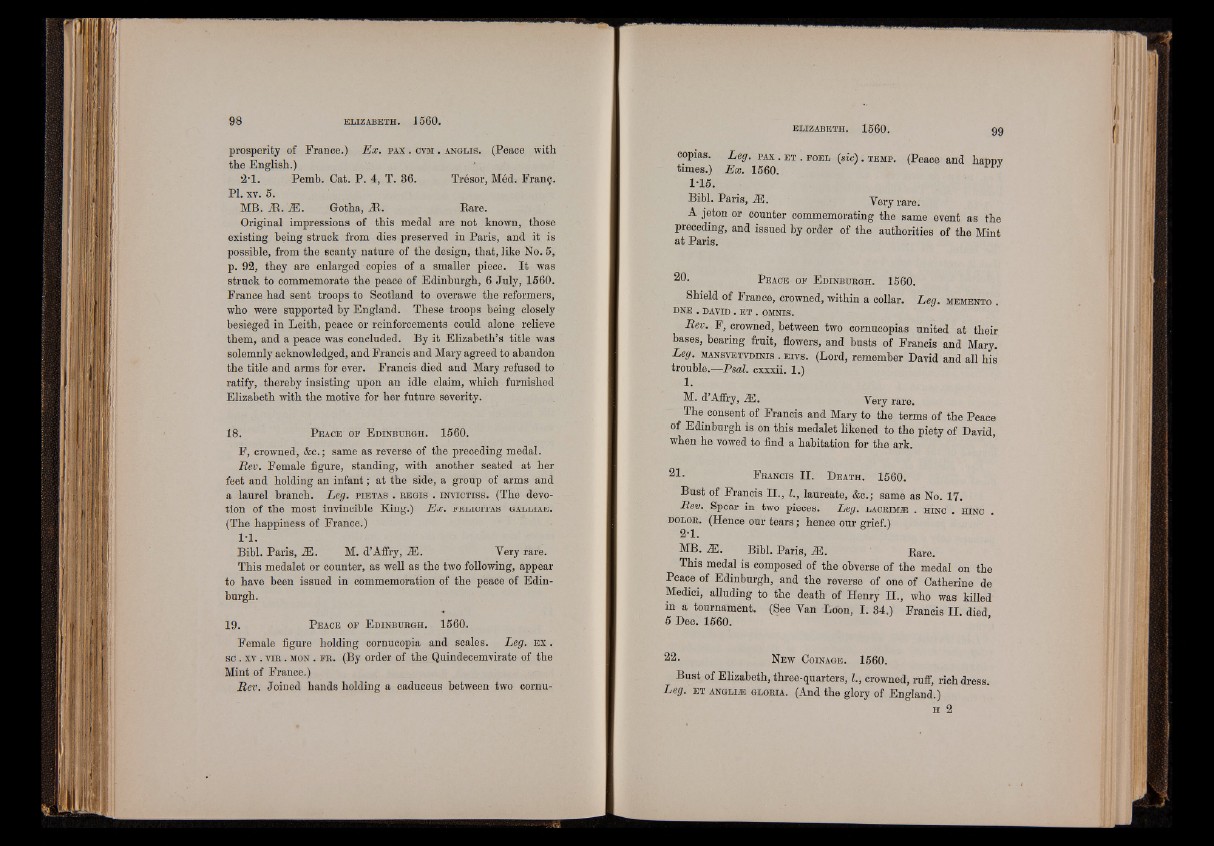
prosperity of France.) Ex. p a x . cvm . a n g l e s . (Peace with
the English.)
2T. Pemb. Cat. P. 4, T. 36. Trésor, Méd. Franç.
PI. XT. 5.
MB. Æ. Æ. Gotha, Æ. Bare.
Original impressions of this medal are not known, those
existing being struck from dies preserved in Paris, and it is
possible, from the scanty nature of the design, that, like No. 5,
p. 92, they are enlarged copies of a smaller piece. It was
struck to commemorate the peace of Edinburgh, 6 July, 1560.
France had sent troops to Scotland to overawe the reformers,
who were supported by England. These troops being closely
besieged in Leith, peace or reinforcements could alone relieve
them, and a peace was concluded. By it Elizabeth’s title was
solemnly acknowledged, and Francis and Mary agreed to abandon
the title and arms for ever. Francis died and Mary refused to
ratify, thereby insisting upon an idle claim, which furnished
Elizabeth with the motive for her future severity.
18. P eace oe E dinbuegh. 1560.
F, crowned, &c.; same as reverse of the preceding medal.
Rev. Female figure, standing, with another seated at her
feet and holding an infant ; at the side, a group of arms and
a laurel branch. Leg. p i e t a s . k e g i s . i n v i c t i s s . (The devotion
of the most invincible King.) Ex . f é l i c i t a s g a l l i a e .
(The happiness of France.)
1-1.
Bibl. Paris, Æ. M. d’Affry, Æ. Very rare.
This medalet or counter, as well as the two following, appear
to have been issued in commemoration of the peace of Edinburgh.
19. P eace of E dinbuegh. 1560.
Female figure holding cornucopia and scales. Leg. e x .
sc . x v . v i e . m o n . f e . (By order of the Quindecemvirate of the
Mint of France.)
Rev. Joined hands holding a caduceus between two cornucopias.
Leg. p a x . e t . f o e l (sic). t em p . (Peace and happy
times.) Ex. 1560.
1-15.
Bibl. Paris, M . Very rare.
A jeton or counter commemorating the same event as the
preceding, and issued by order of the authorities of the Mint
at Paris.
2 0 - P e a c e o f E d i n b u e g h . 1560.
Shield of France, crowned, within a collar. Leg. m em e n to .
DNE . DAVID . ET . OMNIS.
Rev. F, crowned, between two cornucopias united at their
bases, bearing fruit, flowers, and busts of Francis and Mary.
Leg. m a n s v e tv d in i s . EIVS. (Lord, remember David and all his
trouble.—Psal. cxxxii. 1 .)
1 .
M. d’Affry, M . Very rare.
The consent of Francis and Mary to the terms of the Peace
of Edinburgh is on this medalet likened to the piety of David,
when he vowed to find a habitation for the ark.
2 1 - F e a n c i s II. D e a t h . 1560.
Bust of Francis II., I., laureate, &e.; same as No. 17.
Rev. Spear in two pieces. Leg. l a c e d l e . h i n c . h i n c .
d o l o e . (Hence our tears; hence our grief.)
2-1.
MB. .33. Bibl. Paris, M. Bare.
This medal is composed of the obverse of the medal on the
Peace of Edinburgh, and the reverse of one of Catherine de
Medici, alluding to the death of Henry H., who was killed
in a tournament. (See Yan Loon, I. 34.) Francis II. died
5 Dec. 1560. ’
22. N e w C o in a g e . 1560.
Bust of Elizabeth, three-quarters, I., crowned, ruff, rich dress.
Leg. ET a n g l l e g l o e i a . (And the glory of England.)
h 2